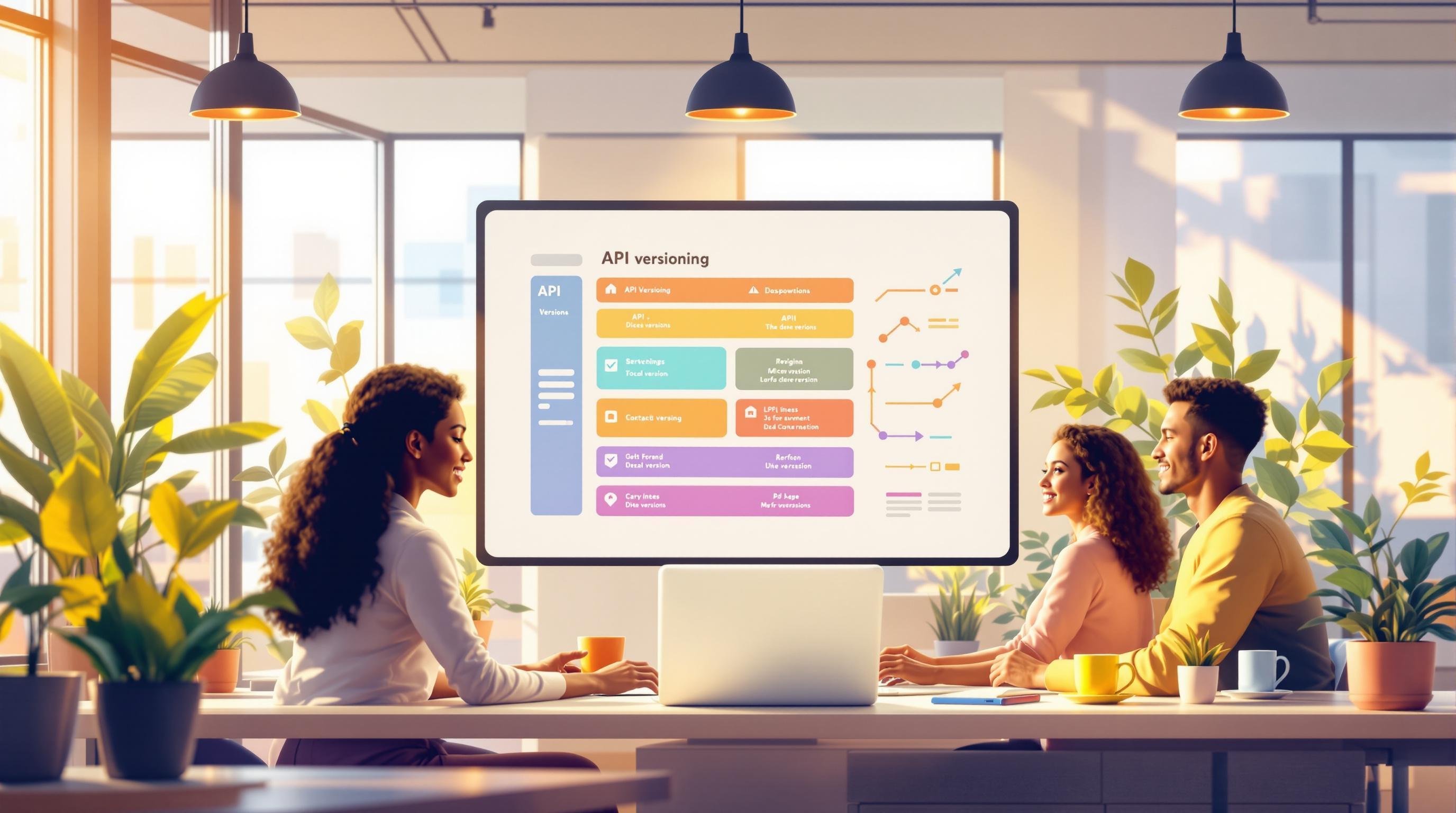Managing API versions is essential for keeping cross-platform applications stable and user-friendly. Here's what you need to know:
Why Versioning Matters: It ensures compatibility across platforms like mobile, web, and IoT, each with unique update cycles.
Key Benefits:
- Controlled updates without breaking existing integrations.
- Gradual rollouts to test changes safely.
- Flexibility for users to upgrade at their pace.
Top Practices:
- Maintain backward compatibility by keeping legacy features intact.
- Provide clear documentation with migration guides and examples.
- Prioritize security with features like API keys, RBAC, and encryption.
Common Versioning Methods:
- URL Path Versioning: Include version numbers in URLs (e.g.,
v1,v2). - HTTP Header Versioning: Specify versions in request headers for cleaner URLs.
Quick Comparison of Versioning Methods:
|
Feature |
URL Path Versioning |
HTTP Header Versioning |
|---|---|---|
|
Version Visibility |
High (visible in URL) |
Low (in headers) |
|
Cache Management |
Simple |
More complex |
|
Client Implementation |
Easy |
Requires handling headers |
|
Documentation |
Straightforward |
Needs header details |
|
Cross-Platform Support |
Excellent |
Good |
Choosing the Right Method: Consider your client platforms, caching needs, and long-term maintenance goals.
Pro Tip: Tools like DreamFactory simplify API versioning by automating REST API creation, enhancing security, and providing robust documentation.
Versioning APIs helps you manage updates smoothly, maintain security, and support diverse platforms effectively.
API Versioning Strategies | Why and How | URL, Headers ...
Key Requirements for Cross-Platform API Versioning
To create a stable and scalable API ecosystem, you need to focus on three core areas: backward compatibility, clear documentation, and strong security. These elements ensure your API remains functional, user-friendly, and protected as it evolves.
Maintaining Backward Compatibility
New API versions should never break existing applications. Here are some practices to follow:
- Add new features without removing old ones.
- Keep legacy data formats intact.
- Use default values for newly introduced parameters.
- Keep deprecated endpoints operational during migration periods.
It's also crucial to test each version thoroughly, especially considering the slower update cycles for mobile apps.
API Documentation Standards
Every API version needs comprehensive documentation. This should include a version history log, detailed endpoint specifications, migration guides, and sample code to assist developers.
Security and Compliance Rules
Security must remain a priority, even as new threats and compliance standards emerge. Key steps include:
- Implementing strong authentication methods like RBAC, API keys, or OAuth.
- Applying version-specific security measures such as encryption, rate limiting, and access controls.
- Conducting regular audits and automated checks to ensure compliance.
Real-world examples highlight the importance of these practices. For instance, Deloitte improved ERP data integration by enabling secure, real-time access to executive dashboards via REST APIs. Similarly, Pillsbury Law enhanced its IT infrastructure by securely synchronizing HR and SharePoint data through robust API management.
"It's rare when a product this good comes along!" - Rana Azeem, Senior Software Engineer, McAfee [1]
API Versioning Methods
Selecting the right API versioning method is crucial for maintaining compatibility and ensuring smooth transitions across platforms. Below, we break down two commonly used approaches.
URL Path Versioning
This method embeds the version number directly into the URL, making it easy to identify which version is in use:
- https://api.example.com/v1/users
- https://api.example.com/v2/users
This setup makes migrations more straightforward and simplifies support for older versions.
Key points to consider:
- Ensure URLs remain consistent across platforms.
- Use whole numbers for major versions (e.g., v1, v2).
- Maintain a logical version hierarchy.
- Provide clear documentation for URL patterns.
HTTP Header Versioning
For those who prefer cleaner URLs, header-based versioning allows specifying the version through custom headers:
Accept: application/vnd.api+json; version=1.0
This approach keeps the URL structure tidy while offering precise version control.
Comparing Versioning Methods
|
Feature |
URL Path Versioning |
HTTP Header Versioning |
|---|---|---|
|
Version Visibility |
High – easy to spot in the URL |
Low – requires checking headers |
|
Cache Management |
Simpler – URLs are cache-friendly |
More complex – involves headers |
|
Client Implementation |
Easy – no special headers needed |
Requires handling custom headers |
|
Documentation |
Easier to document and test |
Needs additional header details |
|
Cross-Platform Support |
Excellent – works universally |
Good – may need platform-specific tweaks |
Choosing the Right Approach
When deciding on a versioning method, take into account:
- The capabilities of your client platforms.
- How caching will be managed.
- The importance of API version visibility.
- The expertise of your development team.
- Plans for long-term maintenance.
Pick the strategy that aligns best with your technical needs and future goals.
API Version Management Guidelines
Managing API versions requires careful planning, clear communication, and well-defined rules for their lifecycle. Here's a breakdown of how to handle API versioning effectively.
Planning and Testing
Start with thorough planning and rigorous testing. Create a structured release process that includes internal testing, partner trials, phased rollouts, and ongoing maintenance. Use automated tests to ensure:
- Compatibility across platforms
- Backward compatibility
- Proper endpoint responses
- Performance benchmarks
- Reliable error handling
These steps lay the groundwork for smooth API updates. Once your plan is solid, focus on communicating changes effectively to avoid disruptions.
Communicating Updates
Clear communication is key to helping developers adjust to API changes. Here's how to keep them informed:
- Maintain an up-to-date changelog
- Provide step-by-step migration guides for major updates
- Clearly outline breaking changes
- Announce major updates well in advance
- Share regular technical updates and migration tips during the transition
- Offer detailed release notes with instructions and support contact details
Managing Version Lifecycles
After setting up your testing and communication plans, establish clear rules for handling API version lifecycles:
- Define support timelines, including deprecation policies with clear end dates and migration recommendations
- Allow a grace period where older versions remain accessible but issue deprecation warnings
- After the grace period, redirect requests for outdated versions to error endpoints with upgrade instructions
Monitoring and Maintenance:
- Track usage metrics for each version
- Monitor error rates and overall performance
- Gather feedback on migration challenges
- Adjust support timelines based on adoption trends
These steps ensure a smoother experience for both developers and end users while keeping your APIs reliable and up-to-date.
DreamFactory API Management Features

DreamFactory offers tools designed to simplify API versioning, making development faster while keeping security and reliability at the forefront.
API Creation Tools
DreamFactory automates REST API generation, saving time and effort. It can instantly create secure REST API endpoints for database tables, views, or stored procedures - no manual coding required. Key benefits include:
- Fast Development: Create production-ready APIs in just 5 minutes.
- Cost Savings: Reduces API implementation costs by $45,719 per project.
- Schema Conversion: Automatically transforms database schemas into REST structures.
These tools make API creation straightforward and efficient, laying the groundwork for the platform’s robust security features.
Security Controls
DreamFactory prioritizes security in API versioning with features aimed at reducing risks. Some of the key security measures include:
- Role-Based Access Control (RBAC): Manage permissions for different API versions with precision.
- Authentication Options: Supports OAuth, SAML, Active Directory, and more.
- API Key Management: Centralized control over access credentials.
- Rate Limiting: Customizable limits to prevent overuse or abuse.
Documentation and Deployment Options
DreamFactory simplifies documentation and deployment, offering flexible solutions suited for various platforms and environments.
Deployment Options:
- Kubernetes orchestration
- Docker containers
- Linux systems
- Cloud-based platforms
Integration Features:
- Connects with over 20 databases
- Provides a unified REST endpoint for multiple data sources
- Automatically generates Swagger documentation
"DreamFactory streamlines everything and makes it easy to concentrate on building your front end application. I had found something that just click, click, click... connect, and you are good to go." - Edo Williams, Lead Software Engineer, Intel [1]
The platform ensures all API versions are well-documented and accessible. With deployment options that work across different environments, teams can maintain consistency and efficiency.
Conclusion
API versioning plays a key role in ensuring systems work smoothly across platforms while maintaining efficient and stable operations over time. A great example is the Vermont Department of Transportation, which successfully linked 1970s legacy systems with modern databases through secure REST APIs. This highlights how structured versioning simplifies data integration during system upgrades.
Effective API management doesn't just improve integration - it also saves money and reduces risks. For instance, proper API handling can cut annual development costs by up to $201,783 and lower security risks by 99% [1]. D.A. Davidson provides a real-world example, revamping its investor portal with secure, real-time updates.
"It's rare when a product this good comes along!" - Rana Azeem, Senior Software Engineer, McAfee [1]
Looking ahead, automation and intelligent management systems will shape the future of API versioning. These tools will tackle the challenges of cross-platform integration while maintaining high security and performance standards. As digital ecosystems grow, robust API versioning strategies will become even more critical. DreamFactory exemplifies this future with its fast, secure API creation.
As highlighted by industry experts:
"DreamFactory is far easier to use than our previous API management provider, and significantly less expensive." - Adam Dunn, Sr. Director, Global Identity Development & Engineering, McKesson
Terence Bennett, CEO of DreamFactory, has a wealth of experience in government IT systems and Google Cloud. His impressive background includes being a former U.S. Navy Intelligence Officer and a former member of Google's Red Team. Prior to becoming CEO, he served as COO at DreamFactory Software.
























 Blog
Blog



